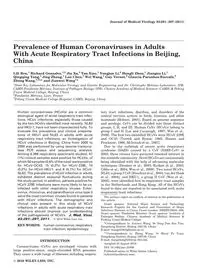
2011 Prevalence of human coronaviruses in adults with acute respiratory tract infections in Beijing, China PDF
Preview 2011 Prevalence of human coronaviruses in adults with acute respiratory tract infections in Beijing, China
Journal of Medical Virology 83:291–297 (2011) Prevalence of Human Coronaviruses in Adults With Acute Respiratory Tract Infections in Beijing, China Lili Ren,1 Richard Gonzalez,1,2 Jin Xu,3 Yan Xiao,1 Yongjun Li,2 Hongli Zhou,1 Jianguo Li,1 Qingqing Yang,1 Jing Zhang,1 Lan Chen,1 Wei Wang,1 Guy Vernet,2 Gla´ucia Paranhos-Baccala`,2 Zhong Wang,1,3** and Jianwei Wang1* 1State Key Laboratory for Molecular Virology and Genetic Engineering and Dr. Christophe Me´rieux Laboratory, IPB, CAMS-Fondation Me´rieux, Institute of Pathogen Biology (IPB), Chinese Academy of Medical Sciences (CAMS) & Peking Union Medical College, Beijing, China 2Fondation Me´rieux, Lyon, France 3Peking Union Medical College Hospital, CAMS, Beijing, China Human coronaviruses (HCoVs) are a common etiological agent of acute respiratory tract infec- tions. HCoV infections, especially those caused by the two HCoVs identified most recently, NL63 and HKU-1, have not been characterized fully. To evaluate the prevalence and clinical presenta- tions of HKU1 and NL63 in adults with acute respiratory tract infections, an investigation of HCoV infections in Beijing, China from 2005 to 2009 was performed by using reverse transcrip- tase PCR assays and sequencing analysis. Among 8,396 respiratory specimens studied, 87 (1%) clinical samples were positive for HCoVs, of which 50 samples (0.6% of the total) were positive for HCoV-OC43, 15 (0.2%) for HCoV-229E, 14 (0.2%) for HCoV-HKU1, and 8 (0.1%) for HCoV- NL63. The prevalence of HCoV infection in adults exhibited distinct seasonal fluctuations during the study period. In addition, patients positive for HCoV-229E infections were more likely to be co- infected with other respiratory viruses. Enter- ovirus, rhinovirus, and parainfluenza virus type 3 were the most common viruses found in patients with HCoV infections. The demographic and clinical data present in this study of HCoV infections in adults with acute respiratory tract infections should improve our understanding of the pathogenesis of HCoVs. J. Med. Virol. 83:291–297, 2011. � 2010 Wiley-Liss, Inc. KEY WORDS: human coronavirus; respiratory tract infection; epidemiology INTRODUCTION Coronaviruses (CoVs) are enveloped viruses with large positive-sense, single-stranded RNA genomes. They cause a wide range of illnesses including respira- tory tract infections, diarrhea, and disorders of the central nervous system in birds, humans, and other mammals [Holmes, 2001]. Based on genome sequence and serology, CoVs can be divided into three distinct groups, I, II, and III. Human CoVs (HCoVs) belong to group I and II [Lai and Cavanagh, 1997; Woo et al., 2009]. The first two identified HCoVs were HCoV 229E and OC43 [Tyrrell and Bynoe, 1965; Hamre and Procknow, 1966; McIntosh et al., 1967]. Due to the outbreak of severe acute respiratory syndrome (SARS) caused by a CoV (SARS-CoV) in 2003, these viruses have garnered renewed interest in the scientific community. Novel HCoVsare continuously being identified with the help of advancing molecular techniques [Drosten et al., 2003; Kuiken et al., 2003; Gibbs et al., 2004; Woo et al., 2009]. Two novel HCoVs, NL63, a group I CoV [Fouchier et al., 2004; van der Hoek et al., 2004], and HKU1, a group II CoV [Woo et al., 2005], were identified first in respiratory tract samples in the Netherlands and Hong Kong. All of the HCoVs found to date are reported to be associated with acute respiratory tract infections. The authors report no conflicts of interest in the publication of this article. Grant sponsor: National Major Science and Technology Research Projects for the Control and Prevention of Major Infectious Diseases in China; Grant number: 2009ZX10004–206; Grant sponsor: Fondation Merieux; Grant sponsor: Institute of Pathogen Biology, Chinese Academy of Medical Sciences & Pecking Union Medical College. *Correspondence to: Jianwei Wang, 9# Dong Dan San Tiao, Dongcheng District, Beijing 100730, China. E-mail:
